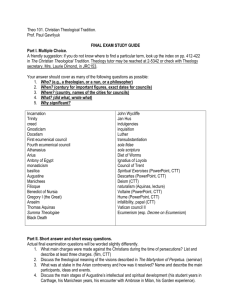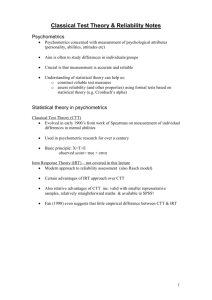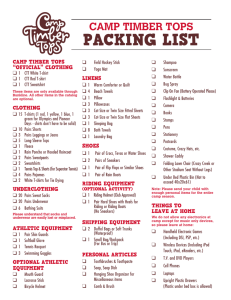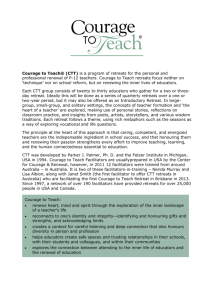Introduction to Item Response Theory
advertisement
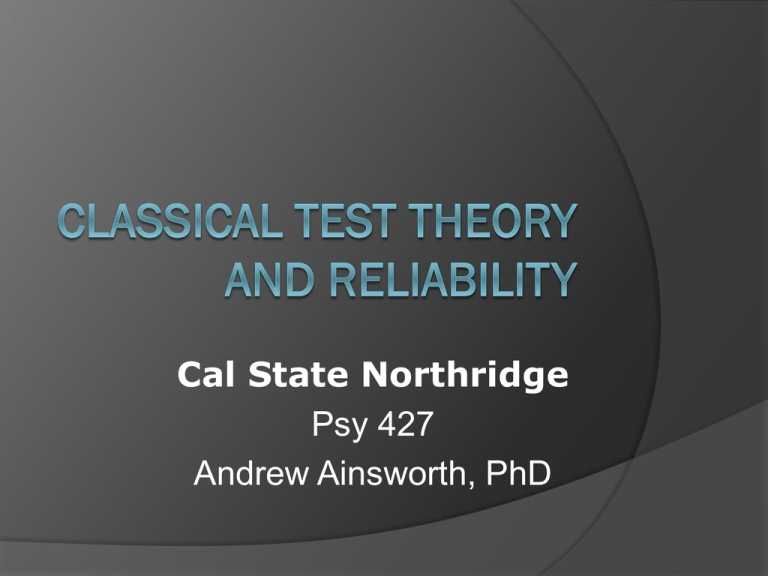
Cal State Northridge Psy 427 Andrew Ainsworth, PhD Basics of Classical Test Theory Theory and Assumptions Types of Reliability Example Classical Test Theory Test Theory (CTT) – often called the “true score model” Called classic relative to Item Response Theory (IRT) which is a more modern approach CTT describes a set of psychometric procedures used to test items and scales reliability, difficulty, discrimination, etc. Classical Classical Test Theory CTT analyses are the easiest and most widely used form of analyses. The statistics can be computed by readily available statistical packages (or even by hand) CTT Analyses are performed on the test as a whole rather than on the item and although item statistics can be generated, they apply only to that group of students on that collection of items Classical Test Theory Assumes that every person has a true score on an item or a scale if we can only measure it directly without error CTT analyses assumes that a person’s test score is comprised of their “true” score plus some measurement error. This is the common true score model X T E Classical Test Theory Based on the expected values of each component for each person we can see that ( X i ) ti Ei X i ti ( X i ti ) ( X i ) (ti ) ti ti 0 E and X are random variables, t is constant However this is theoretical and not done at the individual level. Classical Test Theory If we assume that people are randomly selected then t becomes a random variable as well and we get: X T E Therefore, in CTT we assume that the error : Is normally distributed Uncorrelated with true score Has a mean of Zero Without meas T With meas X=T+E True Scores T1 T2 T3 Measurement error around a T can be large or small Domain Sampling Theory Another Central Component of CTT Another way of thinking about populations and samples Domain - Population or universe of all possible items measuring a single concept or trait (theoretically infinite) Test – a sample of items from that universe Domain Sampling Theory A person’s true score would be obtained by having them respond to all items in the “universe” of items We only see responses to the sample of items on the test So, reliability is the proportion of variance in the “universe” explained by the test variance Domain Sampling Theory A universe is made up of a (possibly infinitely) large number of items So, as tests get longer they represent the domain better, therefore longer tests should have higher reliability Also, if we take multiple random samples from the population we can have a distribution of sample scores that represent the population Domain Sampling Theory Each random sample from the universe would be “randomly parallel” to each other Unbiased estimate of reliability r1t r1 j r 1t = correlation between test and true score r 1 j = average correlation between the test and all other randomly parallel tests Classical Test Theory Reliability Reliability is theoretically the correlation between a test-score and the true score, squared Essentially the proportion of X that is T This 2 XT 2 2 T E 2 T 2 X 2 T can’t be measured directly so we use other methods to estimate CTT: Reliability Index Reliability can be viewed as a measure of consistency or how well as test “holds together” Reliability is measured on a scale of 0-1. The greater the number the higher the reliability. CTT: Reliability Index The approach to estimating reliability depends on Estimation of “true” score Source of measurement error Types of reliability Test-retest Parallel Forms Split-half Internal Consistency CTT: Test-Retest Reliability Evaluates the error associated with administering a test at two different times. Time Sampling Error How-To: Give test at Time 1 Give SAME TEST at Time 2 Calculate r for the two scores • Easy to do; one test does it all. CTT: Test-Retest Reliability Assume 2 administrations X1 and X2 ( X1i ) ( X 2i ) X1 X 2 2 E2 i 2 X X T 2 XT X X X 1 1 The 2 E1i 2 2 correlation between the 2 administrations is the reliability CTT: Test-Retest Reliability Sources of error random fluctuations in performance uncontrolled testing conditions ○ extreme changes in weather ○ sudden noises / chronic noise ○ other distractions internal factors ○ illness, fatigue, emotional strain, worry ○ recent experiences CTT: Test-Retest Reliability Generally used to evaluate constant traits. Intelligence, personality Not appropriate for qualities that change rapidly over time. Mood, hunger Problem: Carryover Effects Exposure to the test at time #1 influences scores on the test at time #2 Only a problem when the effects are random. If everybody goes up 5pts, you still have the same variability CTT: Test-Retest Reliability Practice effects Type of carryover effect Some skills improve with practice ○ Manual dexterity, ingenuity or creativity Practice effects may not benefit everybody in the same way. Carryover & Practice effects more of a problem with short inter-test intervals (ITI). But, longer ITI’s have other problems developmental change, maturation, exposure to historical events CTT: Parallel Forms Reliability Evaluates the error associated with selecting a particular set of items. Item Sampling Error How To: Develop a large pool of items (i.e. Domain) of varying difficulty. Choose equal distributions of difficult / easy items to produce multiple forms of the same test. Give both forms close in time. Calculate r for the two administrations. CTT: Parallel Forms Reliability Also Known As: Alternative Forms or Equivalent Forms Can give parallel forms at different points in time; produces error estimates of time and item sampling. One of the most rigorous assessments of reliability currently in use. Infrequently used in practice – too expensive to develop two tests. CTT: Parallel Forms Reliability Assume 2 parallel tests X and X’ (Xi ) (X ) ' i 2 Ei 2 Ei' XX ' XX ' XT X X ' 2 T 2 X The correlation between the 2 parallel forms is the reliability CTT: Split Half Reliability What if we treat halves of one test as parallel forms? (Single test as whole domain) That’s what a split-half reliability does This is testing for Internal Consistency Scores on one half of a test are correlated with scores on the second half of a test. Big question: “How to split?” First half vs. last half Odd vs Even Create item groups called testlets CTT: Split Half Reliability How to: Compute scores for two halves of single test, calculate r. Problem: Considering the domain sampling theory what’s wrong with this approach? A 20 item test cut in half, is 2 10-item tests, what does that do to the reliability? If only we could correct for that… Spearman Brown Formula Estimates the reliability for the entire test based on the split-half Can also be used to estimate the affect changing the number of items on a test has on the reliability j (r ) r 1 ( j 1)r * Where r* is the estimated reliability, r is the correlation between the halves, j is the new length proportional to the old length Spearman Brown Formula For a split-half it would be 2(r ) r (1 r ) * Since the full length of the test is twice the length of each half Spearman Brown Formula Example 1: a 30 item test with a split half reliability of .65 2(.65) r .79 (1 .65) * The .65 .79 is a much better reliability than the Spearman Brown Formula Example 2: a 30 item test with a test retest reliability of .65 is lengthened to 90 items 3(.65) 1.95 r * 1 (3 1).65 2.3 .85 Example 3: a 30 item test with a test retest reliability of .65 is cut to 15 items .5(.65) .325 r .48 1 (.5 1).65 .675 * Detour 1: Variance Sum Law Often multiple items are combined in order to create a composite score The variance of the composite is a combination of the variances and covariances of the items creating it General Variance Sum Law states that if X and Y are random variables: 2 X Y 2 XY 2 X 2 Y Detour 1: Variance Sum Law Given multiple variables we can create a variance/covariance matrix For 3 items: X1 X1 X2 X3 X2 X3 12 13 2 21 2 23 2 31 32 3 2 1 Detour 1: Variance Sum Law Example Variables X, Y and Z Covariance Matrix: X Y Z X 55.83 29.52 30.33 Y 29.52 17.49 16.15 Z 30.33 16.15 29.06 By the variance sum law the composite variance would be: 2 X Y Z 2 Total 2 XY 2 XZ 2 YZ 2 X 2 Y 2 Z Detour 1: Variance Sum Law X Y Z X 55.83 29.52 30.33 Y 29.52 17.49 16.15 Z 30.33 16.15 29.06 By the variance sum law the composite variance would be: 2 Total s 55.83 17.49 29.06 2(29.52) 2(30.33) 2(16.15) 254.41 CTT: Internal Consistency Reliability If items are measuring the same construct they should elicit similar if not identical responses Coefficient OR Cronbach’s Alpha is a widely used measure of internal consistency for continuous data Knowing the a composite is a sum of the variances and covariances of a measure we can assess consistency by how much covariance exists between the items relative to the total variance CTT: Internal Consistency Reliability Coefficient Alpha k sij 2 k 1 sTotal is defined as: 2 s Total is the composite variance (if items were summed) sij is covariance between the ith and jth items where i is not equal to j k is the number of items CTT: Internal Consistency Reliability Using the same continuous items X, Y and Z The covariance matrix is: X Y Z The X 55.83 29.52 30.33 Y 29.52 17.49 16.15 Z 30.33 16.15 29.06 total variance is 254.41 The sum of all the covariances is 152.03 k sij 3 152.03 2 .8964 k 1 sTotal 3 1 254.41 CTT: Internal Consistency Reliability Coefficient Alpha can also be defined as: 2 2 k sTotal si 2 k 1 sTotal 2 s Total is the composite variance (if items were summed) 2 si is variance for each item k is the number of items CTT: Internal Consistency Reliability Using the same continuous items X, Y and Z The covariance matrix is: X Y Z X 55.83 29.52 30.33 Y 29.52 17.49 16.15 Z 30.33 16.15 29.06 The total variance is 254.41 The sum of all the variances is 102.38 2 2 k sTotal si 3 254.41 102.38 .8964 2 k 1 sTotal 254.41 3 1 CTT: Internal Consistency Reliability From SPSS ****** Method 1 (space saver) will be used for this analysis ****** R E L I A B I L I T Y A N A L Y S I S - S C A L E (A L P H A) Reliability Coefficients N of Cases = Alpha = 100.0 .8964 N of Items = 3 CTT: Internal Consistency Reliability Coefficient Alpha is considered a lowerbound estimate of the reliability of continuous items It was developed by Cronbach in the 50’s but is based on an earlier formula by Kuder and Richardson in the 30’s that tackled internal consistency for dichotomous (yes/no, right/wrong) items Detour 2: Dichotomous Items If Y is a dichotomous item: P = proportion of successes OR items answer correctly Q = proportion of failures OR items answer incorrectly Y = P, observed proportion of successes 2 sY = PQ CTT: Internal Consistency Reliability Kuder and Richardson developed the KR20 that is defined as 2 k sTotal pq 2 k 1 sTotal Where pq is the variance for each dichotomous item The KR21 is a quick and dirty estimate of the KR20 CTT: Reliability of Observations What if you’re not using a test but instead observing individual’s behaviors as a psychological assessment tool? How can we tell if the judge’s (assessor’s) are reliable? CTT: Reliability of Observations Typically a set of criteria are established for judging the behavior and the judge is trained on the criteria Then to establish the reliability of both the set of criteria and the judge, multiple judges rate the same series of behaviors The correlation between the judges is the typical measure of reliability But, couldn’t they agree by accident? Especially on dichotomous or ordinal scales? CTT: Reliability of Observations Kappa is a measure of inter-rater reliability that controls for chance agreement Values range from -1 (less agreement than expected by chance) to +1 (perfect agreement) +.75 “excellent” .40 - .75 “fair to good” Below .40 “poor” Standard Error of Measurement So far we’ve talked about the standard error of measurement as the error associated with trying to estimate a true score from a specific test This error can come from many sources We can calculate it’s size by: smeas s 1 r s is the standard deviation; r is reliability Standard Error of Measurement Using the same continuous items X, Y and Z The total variance is 254.41 s = SQRT(254.41) = 15.95 = .8964 smeas 15.95* 1 .8964 5.13 CTT: The Prophecy Formula How much reliability do we want? Typically we want values above .80 What if we don’t have them? The Spearman-Brown can be algebraically manipulated to achieve rd (1 ro ) j ro (1 rd ) j = # of tests at the current length, rd = desired reliability, ro = observed reliability CTT: The Prophecy Formula Using the same continuous items X, Y and Z = .8964 What if we want a .95 reliability? rd (1 ro ) .95(1 .8964) .0984 j 2.2 ro (1 rd ) .8964(1 .95) .0448 We need a test that is 2.2 times longer than the original Nearly 7 items to achieve .95 reliability CTT: Attenuation Correlations are typically sought at the true score level but the presence of measurement error can cloud (attenuate) the size the relationship We can correct the size of a correlation for the low reliability of the items. Called the Correction for Attenuation CTT: Attenuation Correction for attenuation is calculated as: r12 rˆ12 r11r22 r̂12 is the corrected correlation r12 is the uncorrected correlation r11 and r22 the reliabilities of the tests CTT: Attenuation For example X and Y are correlated at .45, X has a reliability of .8 and Y has a reliability of .6, the corrected correlation is r12 .45 .45 rˆ12 .65 r11r22 .8*.6 .48

